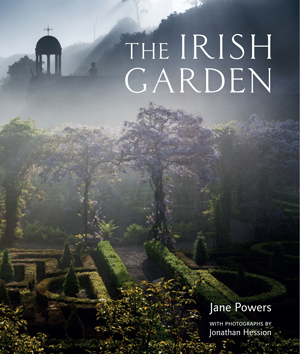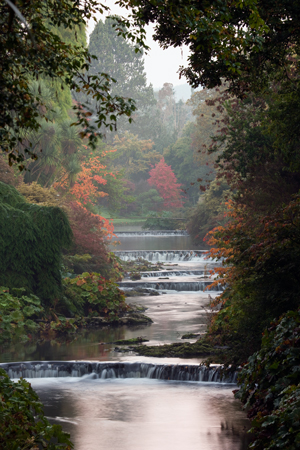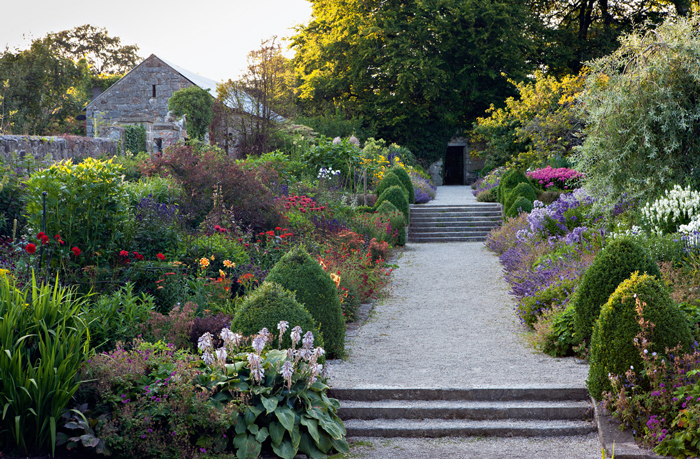The Irish Garden
I have said many times before that I think Irish Gardens are not given the recognition that they truly deserve. New books on Irish Gardens are few and far between and so I was delighted to receive ‘The Irish Garden’ by Jane Powers from publishers Frances Lincoln.
Visitors to Ireland, both north and south, are often surprised at the “palm trees” that make so many gardens look as if they belong in a holiday postcard. I well remember being surprised at the variety of planting at Mount Stewart in County Down when I visited some years ago and that visit gave me a taste for Irish Gardens and a desire to see more.
 I particularly like the way the author has approached this book. It is a weighty tome, packed as you might imagine with some wonderful illustrations and colour plates by photographer Jonathan Hession, who is married to the author. Their collaboration has brought together an outstanding array of gardens which the author has arranged by theming the gardens into various categories from Grand Big Gardens, Taming the Wilderness and Painting with Plants to Good Enough to Eat, A Few Follies and Fancies and Paradises Reinvented.
I particularly like the way the author has approached this book. It is a weighty tome, packed as you might imagine with some wonderful illustrations and colour plates by photographer Jonathan Hession, who is married to the author. Their collaboration has brought together an outstanding array of gardens which the author has arranged by theming the gardens into various categories from Grand Big Gardens, Taming the Wilderness and Painting with Plants to Good Enough to Eat, A Few Follies and Fancies and Paradises Reinvented.
There are nearly 60 gardens included in the book – some big, some small, some grand and some cosy. As Jane and Jonathan point out in the Preface, Irish gardeners are possessed of an almost supernatural dynamism and energy, continually pushing their plots into greater creative zones. One can imagine the joy and happiness spent by the authors in visiting the gardens featured in the book and that joy is evident in both the written and photographic components of the book.
Each garden is given a good amount of space, both the printed information and the photographs, so you really feel you can get under the skin of them rather than skimming over a brief page. The author also sets the scene of each garden vividly and clearly, so I was able to visualize quickly the kind of environment the garden was situated in.
Her entertaining text also took me through a variety of emotions, not something I expected. The history of some of the gardens is shrouded in a kind of sadness while others exude a joy of rejuvenation and growth.
Glenveagh in County Donegal is typical – wild and remote with powerful weather systems sweeping in from the Atlantic – its rough terrain is a surprising setting for one of Ireland’s most lush and enthralling gardens. The gardens were laid out by Cornelia Adair whose husband John, was a land speculator and money broker, with a miserable record of treatment for his tenants. He evicted 244 tenants in 1861 and leveled their houses. In 1921, the estate passed to her grandson who had little interest in the property.
Glenveagh became neglected and then during the Irish Civil War it was first occupied by the anti-Treaty forces and then by members of the Free State Army. Eventually the castle passed to more caring owners and in 1983 Henry McIlhenny donated the estate and castle to the Irish State.
Altamont (pictured banner above) in County Carlow is another estate featured in the book and again one is immersed in its interesting history and development. With its 18th century walled garden, the all-singing all-dancing double herbaceous border, its round pool and carefully chosen and collected plants with Irish connections, we get a glimpse of the love Corona North dedicated to this garden and the legacy she left for others.
 As the author points out in the Introduction, “Irish gardens are unlike any others in the world. The older ones, made while Ireland was under British rule, contain elements of Englishness, but they are specific to this island on the edge of Europe. The plant palette, the atmosphere and the light could only be Irish.”
As the author points out in the Introduction, “Irish gardens are unlike any others in the world. The older ones, made while Ireland was under British rule, contain elements of Englishness, but they are specific to this island on the edge of Europe. The plant palette, the atmosphere and the light could only be Irish.”
The Irish Garden is the result of a life-time visiting, considering and writing about gardens in Ireland and several years of dedicated photography, this is a truly comprehensive exploration of a fascinating subject. It is also a beautiful book which will entertain the reader over and over again with the gardens chosen. (pictured right Mount Usher)
My only slight niggle is that the book does not contain a map, which would have been useful but there is an excellent select Bibliography and also contact information, which actually gives co-ordinates, so for the technical among us with the joyous satnav finding individual properties should be quite easy.
‘The Irish Garden’ by Jane Powers, with photographs by Jonathan Hession is published in Hardback by Frances Lincoln at £40.00.


